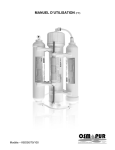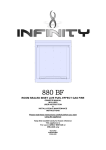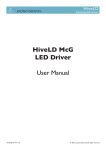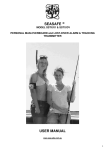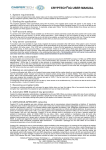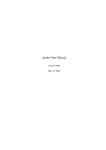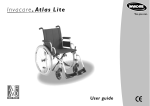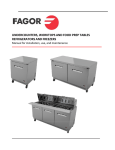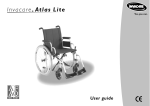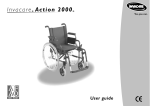Download BMW D7 Owners Manual - Marine spare parts, Marine Technical
Transcript
Owners Manual D7 BMW Marine Engines This copy of the BMW D7 Owners Manual has been re-created using images computer scanned from a manual rather than original artwork. It has also been re-formatted in “portrait” style to display and/or print better on computer systems. 1 This manual was written on your behalf in an effort to help you enjoy your new BMW Marine Engine to the maximum. No marine engine, be it the best in the world, will perform at it’s best during a long life, without proper care and maintenance. Please read this manual carefully before you set out on the first trip with your new BMW Marine Engine. For the practical boat owner, some maintenance procedures are described in this manual. Next to some jobs, you will find this marking which indicates that the work will require special tools as well as certain special knowledge. It is, therefore, recommended that your authorized BMW Marine Dealer complete these operations. 2 INDEX ENGINE DESCRIPTION 4 INSTRUMENTS AND CONTROLS 6 STARTING AND OPERATING 7 SERVICE & MAINTENANCE 12 FUEL SYSTEM 13 LUBRICATION SYSTEM 16 COOLING SYSTEM 17 VALVE SYSTEM 19 ELECTRICAL SYSTEM 20 WINTER LAY UP AND RECOMISSION 21 3 ENGINE DESCRIPTION The BMW D7 is a single-cylinder, four-stroke, direct-injection diesel engine. The engine is equipped with a raw-water cooling system, fed by an impeller type pump driven by the crankshaft. Electrical starting and charging systems are standard as is an automatic air bleeder device in the fuel system. Technical Data Displacement Stroke & Bore Max output at min-1 (RPM) Max torque at min-1 (RPM) Compression Ratio Weight, dry engine incl. Gearbox Gearbox reduction Maximum engine inclination 280cc 67 x 73 mm 4.5 kW / 3600 11.7 Nm / 3300 1.2 kpm / 3300 19:1 68 kg 2.7 15 deg 17.0 cu in 2.63 x 2.87 in 6 HP / 3600 8.7 lb ft / 3300 150 lb. 4 Specifications Fuel Fuel Filter Lubrication oil Type Capacity – Litre (US gal) Air Filter Injector make Injection pressure Injection pump Starter motor make Alternator, charging capacity Battery, rec capacity Polarity Raw-water pump Gearbox Adjustment Data Injection ends Tappet clearance Torque Injector retainer Cylinder head bolts Engine Diesel Oil DIN 51601 (USA #2) BMW 13 32 1 329 270 Gearbox HD-API CC/CD SAE 30 1 litre (0.26 US Gal) BMW 13 71 1 329 269 Bosch 135 + 8 bar Bosch PFE 1 Q 55/19 Bosch 14v 350w 12v 60 Ah Negative ground Johnson Hurth HBW 5 ATF Dexron 0.4 litre (0.1 US Gal) 11.5 – 12.5 deg BTDC 0.15 mm .006 in Nm 10 35 lb.ft 7.2 25 5 INSTRUMENTS & CONTROLS Instruments The BMW D7 is equipped with an instrument panel as shown: 1. Starter Switch – with three positions: ”O” – the circuit is switched off, and the key can be removed ”II” – the current is switched on and the alternator charging control lamp lights ”S” – the started is engaged. When the engine fires the key should be released and will automatically return to position “II” 2. Alternator Charging Control Lamp – is normally out when the engine is running above idle speed 3. Engine Temperature Control Light – should be out at all times except if engine temperature exceeds 70oC or 160oF. In such cases the engine must be stopped at once or severe damage may occur. Find the trouble before the engine is restarted. 4. The panel also has a reserve lamp marked “OIL”, which is not connected Controls Throttle and gearshift are both operated by single-lever remote control, which works as shown: N F1 F2 B1 B2 = = = = = Neutral Forward gear engaged The RPM increases Reverse gear engaged RPM increases To disengage the gearshift mechanism, push the knob – 2 – fully in, for instance when starting the engine. Aloha Owners Association note – the control fitted to Aloha 27s is not always the same as this, and in some cases you pull the knob OUT to disengage. 6 STARTING AND OPERATING The Decompression Valve The automatic decompression valve makes starting easier, particularly manual starting. The valve is operated by a twist grip. In the “O” position the valve is closed, while in the “1” sector it is open, but the automatic control device is not engaged. Turning the grip further – always clock-wise – will engage the automatic control. When the engine is cranked, the valve will automatically return notch by notch to the “0” position. This takes four full turns of the crank handle and the speed gained thereby should make the engine fire at the first following compression stroke. Use of the decompression valve is also helpful when the battery is too low for sufficient cranking speed. NOTE – never use the decompression valve to stop the engine 7 Cold Starting Device Situated next to the injection pump (on the starboard side just forward of the dipstick). When starting a cold engine, the knob is pulled out fully and the RPM control (throttle) in cockpit pushed to the “full” position, with the gear disengaged. Cold Weather Starting Aid A cold start primer is located on top of the cylinder head. Fill with diesel or lubricating oil with the cover removed and press the cove r fully down prior to starting. Engine Shut-Off Control Pull the handle and hold it in this position until the engine has completely stopped. 8 A running-in period of approximately 10 hours when the maximum RPM should not exceed 3000 min-1 will prolong engine and gearbox life. After these 10 hours, the engine should be checked by a BMW Marine Dealer in accordance with the instructions in the service section. Always check the engine oil level, prior to the first starting of the day. Air Bleeding The BMW D7 fuel system incorporates a fully automatic air-bleed device. Prior to starting up after a long rest period or when the fuel system has been worked on, operate the primer pump some 30 – 50 strokes, which will save the battery and starter. (For location of primer pump see diagrams on pages 13 & 15) Starting A Cold Engine § § § § § Check that the gear-shift is in neutral Set the throttle at the “full” position Turn the starter switch key to the “II” position ans check that the alternator charging control lamp comes on Turn the key to the “S” position which will engage the starter motor. When the engine fires evenly, release the starter switch key Set the throttle at normal idling Important – see NOTES on next page. 9 NOTE If outside temperature is extremely low, the primer device on top of the cylinder head (see diagram on page 8) sgould be filled with diesel or lubricating oil and the plug fully pressed down to inject the oil into the intake manifold. NOTE Since a diesel engine is dependent on a certain compression pressure = heat to ignite the fule, one may have to operate the starter for longer periods than is the case with a gasoline engine. Under no circumstances should the starter be engaged for more than thirty seconds at a time. A battery too low for sufficient cranking speed will doom the starting from the beginning and the battery will drain very rapidly. In such a case, try the decompression valve, or crank the engine manually. Starting A Warm Engine § § § § § § § Check that the gear-shift is in neutral Set the throttle at the “full” position Turn the starter switch key to the “II” position ans check that the alternator charging control lamp comes on Turn the key to the “S” position which will engage the starter motor. Release the key as soon as the engine fires Decrease the RPM to normal idling Check that the alternator charging control lamp is out and the gear-shift is reengaged 10 Manual Starting § § § § § § Prepare the starting according to the instructions for a cold engine on page 9 Insert the crank handle and make sure it is properly engaged Turn the decompression valve twist grip almost 180o clockwise Hold the crank handle as shown i.e. with fingers and thumb on the same side of the handle thus avoiding spraining the hands should the engine rotate backwards Crank the engine as rapidly and vigorously as possible. After four crank handle revolutions, the decompression valve will close and the engine will fire normally Remove the crank handle and decrease RPM to normal idling Aloha Owners Association note – owners of some Aloha 27s advise that due to the close proximity of the bulkhead there may be insufficient clearance to allow insertion of the crank handle for manual starting Stopping the engine § § Set the control in neutral and allow the engine a few minutes idling in order to even out any thermal stresses Pull the shut-off handle fully until the engine has completely stopped NOTE – never use the decompression valve to stop the engine 11 SERVICE AND MAINTENANCE Periodical service and maintenance procedures are listed below. The marking indicates that the procedure in question requires special tools and certain knowledge and should be left to your authorized BMW Marine Dealer. Jobs to be done Oil level check Oil change, engine Oil change, gearbox Fuel primary filter, draining Fuel primary filter, cartridge replacement Fuel screen cleaning (inside the feed pump) Air filter, replacement Tappet clearance, checking/adjusting Injector, cleaning Sacrificing anodes, checking/replacing Impeller, raw water pump checking/replacing Decompression valve, adjusting Engine hours Daily 50 or once yearly First change after 10 hours 150 or once yearly Every two weeks 100 or once yearly 100 or once yearly 100 or once yearly Page 16 16 16 13 13 13 15 100 or once yearly 19 When necessary Replaced once yearly 100 or once yearly 100 or whenever tappet clearance is altered 14 18 17 19 12 FUEL SYSTEM Fuel flow circuit Number markings refer to corresponding paragraph 1. The fuel tank – consult the tank manufacturers or boat builders instructions for proper draining, cleaning and other maintenance procedures. NOTE – diesel fuel should not be left in the tank during the lay-up period due to rust, sludge or wax deposits forming. 2. The fuel pump – (located on the port side of the engine) is of the diaphragm type, operated by the camshaft. Underneath the pump housing cover there is a screen type pump which needs cleaning at regular intervals. The filter sealing ring as well as the gasket at the cover centre should be renewed whenever the parts are dismantled. Apart from this, the pump needs no maintenance and is replaced as a complete unit if there are any doubts about it’s functioning. 3. The primary fuel filter – with water trap. Water and dirt deposits are drained by removing the knurled plud with a suitable container underneath to catch the spill. The spin-on type filter cartridge ( Type BMW 13 321 329 270) is replaced at regular intervals – see maintenance schedule on page 12. NOTE – the filter cartridge cannot be cleaned and used again. 13 4. The injection pump – of Bosch make, must not be dealt or tampered with by anyone other than an authorised BMW Marine Engine or Bosch diesel dealer. Should the pump need to be removed, it is very important that all openings, fuel line connectors, etc are properly sealed to prevent contamination. 5. The injector – of Bosch manufacture, will normally need no maintenance except for cleaning of the area nect to the atomizer. The injector must not be dismantled, since the set injection pressure then could be altered inadvertedly. WARNING – when the injector is tested outside the cylinder, the jet must not be directed towards unprotected skin, eyes, etc as it is powerful enough to penetrate the skin, causing nasty wounds and possible infection. When installing the injector, make sure that the cylinder head seal is clean and the nuts evenly tightened to 1.0 kpm (7.2 lb.ft.) 14 6. The return pipes – direct surplus fuel to the tank and evacuate any air locks. NOTE – whenever the fuel system has been serviced, bleeding it by operating the primer pump some 30 – 50 strokes is worthwhile. Any air locks trapped in the system will otherwise cause trouble or make starting impossible. NOTE – handling the fuel system requires total cleanliness. The injection pump and injector tolerances are very fine and any fragment of dirst or the tiniest amount of water could ruin the injector operation. Air filter replacement – is easily carried out by undoing the filter housing clasps. The filter paper element is discarded and cannot be used again. Clean out the filter housing and install a new element. (Type BMW 13 321 329 269) 15 LUBRICATION SYSTEM The BMW D7 is equiped with a simple and relaible splash lubrication system. Oil level check – is done daily with aid of the dipstick Engine oil change – normally every 50 hours. A brand new engine, however, will require it’s first oil change afte r ten or fifteen hours running. Pump out the oil oil via the dipstick opening while the engine is warm. Refill via the crankcase filler plug. Gearbox oil change – is carried out at 150 hour intervals and when the gearbox is still warm. Remove the drain plug – 1 – and the filling opening plug – 2 -. Allow the oil enough time to drain completely. Check that the drain plug seal is undamaged prior to re-installation. Top up the gearbox slowly with 0.4 litres (0.1 US gal) ATF Dexron oil. Leave the filling opening open for some minutes until any possible air locks have escaped. Check the plug seal and install the plug. 16 COOLING SYSTEM The engine has a raw-water direct cooling system fed by an impeller type pump located on the front of the engine and driven b y the crankshaft. The water is circulated through the cylinder block and cylinder head jackets and finally discarded via a thermostat controlled outlet into the exhaust manifold. Pump impeller change – is possible when the pump housing front cover is removed. Pry the impeller off its shaft using two scredrivers. Lubricate the shaft and the impeller vanes with a few drops of oil prior to installation. Bend the vanes opposite to the direction of rotation in order to avoid distortion. Renew the pump housing gasket and install the cover. NOTE – the impeller should be removed prior to lay-up – see instructions on page 21 17 The engine temprature warning light sensor – 1 – and self-sacrificing anodes – 2 – are situated next to the thermostat housing – 3 – . The anodes resist internal corrosion in the cooling system. The self-sacrificing anodes – are checked regularly and replaced if more than 50% has been eaten away by corrosion. Undo the anodes – 2 – and replace them with new ones, including new gaskets. The thermostat – will open at 55oC (130oF). It is accessible when the exhaust manifold is removed – 3 –. Check the thermostat by submerging it in hot water. Always use a new gasket when re-installing the manifold. Draining the cooling system – is done by removing the lower sacrificial anode. 18 VALVE SYSTEM The overhead valves are operated by the camshaft via pushrods and rocker arms. Tappet Clearance § § § § § § § § § § § to be checked and adjusted while the engine is cold set the decompression valve twist grip in the “0” position remove the rocker arm cover, attached with two studs and nuts crank the engine until the compression resistance is clearly noticeable use a feeler gauge to check the clearance between rocker arm and valve. Correct clearance = 0.15mm (.006 in) adjust if necessary by loosening the adjustment screw lock nut at the rocker arm push-rod end – 1 – turn the adjustment screw either way until the correct clearance is achieved hold the screw in position while the lock nut is tightened check the clearance once more repeat the same procedure at the remaining valve re-install the cover with a new gasket The Decompression Valve § § § § § § § § § § is checked and adjusted when the valve mechanism has been worked on or if the proper setting has been altered for othe r reasons affecting the correct functioning of the valve remove the rocker arm cover check and adjust the tappet clearance turn the decompression handle to position “1” undo the decompression valve adjusting screw locknut – 2 – turn the adjustment screw counter-clockwise until the rocker arm clearance is clearly noticeable turn the adjustment screw clockwise until the rocker arm is just in touch with the valve and then another half turn – 180o – in the same direction hold the screw in position while the locknut is tightened install the rocker arm cover and a new gasket set the decompression valve twist grip in “0” position 19 ELECTRICAL SYSTEM The BMW D7 is equipped with a 12 volt electrical system, consisting of a starter motor operating on the flywheel ring gear and an internal alternator with static charging coils inside the flywheel. The maximum charging capacity is 14 V 350 W at 2000 RPM. A panel with rectifier, regulator and fuses completes the installation. The alternator charging control light i n the instrument panel will light up when the starter switch key is turned to “II” position, but should go out when the engine runs, indicating that everything is in order. If not, consult your BMW Marine Dealer as in case of any starter motor malfunctioning. Apart from replacing any burned fuses - make sure that the correct type of replacement is used - the electrical system should need no maintenance. Check, however, that all visible connections are clean and tightened. Wiring Diagram 1 Charge Control Lamp 2 Water Temp Lamp 3 Spare (Oil) Lamp 4 Keyswitch 5 Plug – 9 Pin 6 Water Temp Switch 7 Regulator 8 Impulse Transmitter 9 Plug – 1 Pin 10 Plug – 4 Pin 11 Flywheel Generator 12 Fuse box 25A 13 Starter 14 Battery BL = Blue BR = Brown GE = Yellow GN = Green RT = Red SW = Black WS = White 20 WINTER LAY-UP AND RECOMISSION Prior to winter lay-up or any long periods of rest the engine should he prepared for storage, mainly to fend off corrosion. Either leave this job to the authorized BMW Marine Dealer or do it you according to the following instructions: Before the boat is taken out of the water § warm up the engine and remove the oil, see page 16 § use preservation oil level with the dipstick lower marking § drain the gearbox oil and refill with ATE Dexron oil NOTE - before the engine is recomissioned, the preservation oil must be removed and replaced by recommended engine oil. Some kind of marking is useful as a reminder. § Mix 2 litres (0.5 US gal.) diesel fuel with 1 litre (0.25 US gal.) preservation oil in a suitable container. Connect a hose to the ordinary fuel tank line or directly to the primary filter inlet while the other end is inserted into the container § Start the engine and let it run for approximately 15 minutes On dry land § Drain the engine cooling system, but without removing the cooling water pump impeller § Shut off the raw water inlet and disconnect the raw water pipe at the pump § Mix approximately 12 litres of fresh water with 1.2 litres of emulsifying preservation oil in a container. Always mix the oil with water, not the other way round, and stir vigorously § Connect a hose to the raw-water pump and put the open end in the container § Start the engine and let it idle until the oil/water mixture is nearly gone. Stop the engine. Make sure that no liquid remains in the system since it has no anti-freeze qualities § Remove the injector and pour approximately 1 teaspoonful of oil into the cylinder. Crank the engine a couple of turns and re-install the injector. § Give the engine and gearbox a good cleaning and a coat of oil to prevent rust § Lubricate control cables and linkage. Recomission before launching § Remove all preservation oil in the engine and replace with recommended oil § Install the raw-water pump impeller § Remove the injector and crank the engine a few turns to get rid of surplus oil in the combustion chamber § Change fuel filters § Refuel with fresh diesel fuel. Fuel left in the tank during winter storage should never be used. Check lines and connectors § Start the engine after launching - do not forget to reopen the raw-water inlet. Warm up the engine and check that there are no leaks in fuel or cooling systems. 21





















